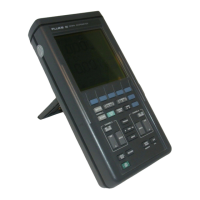PERFORMANCE VERIRCATION PROCEDURE
4.5
Test setup;
Procedure/requirements for channel 6 AC and DC tests:
A Apply 300 mV DC to Channel 6.
6
Change the input voltage and the setting of chanrtet B according to table 4.2 and check that the
amplitude of the signal agrees wi^ the value fisted
.
Use the setect/adjust keys to select each
step number.
NOTE: The AC voltages listed in this are peak-ta-peak voltages (sine wave). The values listed
between brackets
()
are the RMS values that have to be chosen on the Fluke 51008
calibrator.
Requirements:
Table 4.2 Requirements verlicai deflection coefficients for channel B.
Input voltage
Step
number on display Requirements
300 mV DC
"5"
2.94...3.06 div.
600 mV AC
pp
(212.13mV RMS). 1 kHz
-5-
5.88...6-12div.
3VDC
"6"
2.94...3.06 dIv.
eVACpp (2.1213V RMS), 1 kHz
•6"
5.88...6.12div.
30V
DC
"7"
2.94...3.06 div.
60V AC (21.213 V RMS), 1 kHz
'7'
5.88...6.12 div.
The ScopeMeter uses the same input drcultry (hardware) for the SCOPE and the METER modes (In
the above attenuator settings). When the voltage accuracy is checked (see the description "METER
Performance Verification Procedure" step
1).
the deflection coefficients for SCOPE channel A are
also tested.
8/9.
Rise time
The rise lime of the ScopeMeter is checked by means of a fast rise time pulse.
First channel B Is measured.
Test equipment:
Tektronix PQ 506 Square Wave Calibration Generator

